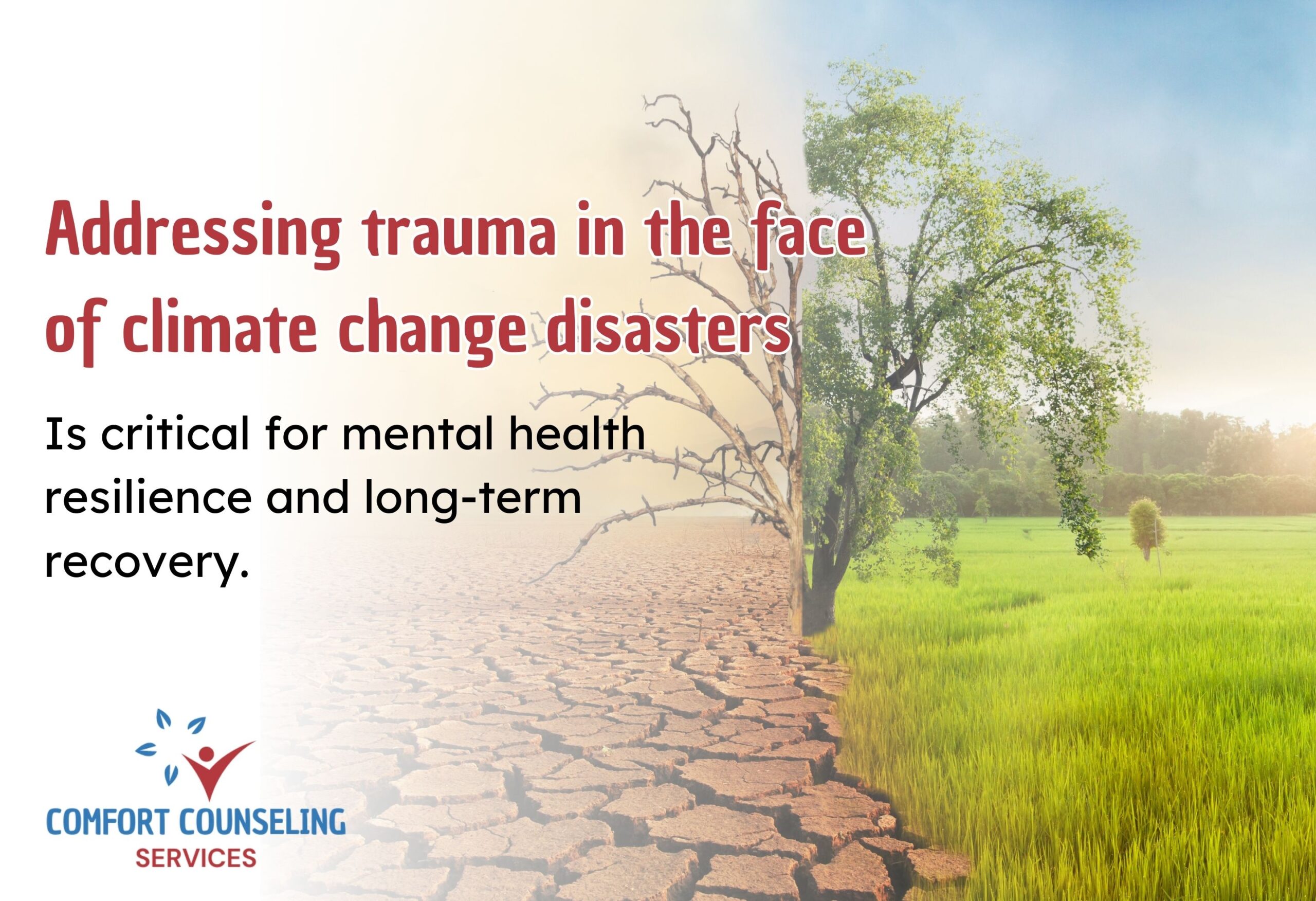As climate change intensifies, the frequency and severity of natural disasters, such as hurricanes, wildfires, floods, and heatwaves, have increased globally. Beyond the visible damage to infrastructure and ecosystems, these disasters leave profound psychological impacts on individuals and communities. Addressing trauma caused by climate change disasters is critical for mental health resilience and long-term recovery.
Understanding climate-related trauma
Climate disasters can cause trauma in both immediate and long-term contexts. Immediate trauma stems from the shock and fear of experiencing a life-threatening event, while long-term trauma arises from displacement, loss of livelihood, or prolonged exposure to environmental uncertainty.
Infographic 1: Psychological impacts of climate disasters
- Acute Stress Disorder (ASD): Intense anxiety immediately after a disaster.
- Post-Traumatic Stress Disorder (PTSD): Long-term distress, including flashbacks and avoidance behaviors (Norris et al., 2002).
- Eco-anxiety: Chronic fear about environmental collapse, particularly among younger generations (Clayton et al., 2017).
- Grief and loss: Emotional suffering from losing homes, loved ones, or ancestral lands.
Vulnerable Populations
Certain groups are more likely to experience trauma due to their heightened vulnerability:
- Children and adolescents: Young individuals are deeply affected by displacement and school disruptions (Masten & Narayan, 2012).
- Marginalized communities: Low-income and minority populations often face greater risks due to inequitable access to resources (Abramson et al., 2015).
- First responders and relief workers: Prolonged exposure to disasters increases the likelihood of burnout and secondary trauma (Creamer et al., 2011).
Trauma responses to climate disasters
Individuals affected by climate disasters may display:
- Physical symptoms
- Fatigue, headaches, and disrupted sleep patterns.
- Emotional reactions
- Anxiety, depression, and feelings of helplessness.
- Behavioural changes
- Increased substance use, isolation, or aggression.
Infographic 2: Common trauma responses
| Symptom | Example |
|---|---|
| Intrusive Thoughts | Nightmares, flashbacks. |
| Avoidance | Reluctance to discuss events. |
| Hyperarousal | Irritability, jumpiness. |
Strategies for addressing trauma
- Building mental health resilience
Resilience can be cultivated through community support, mindfulness practices, and access to mental health resources.
Infographic 3: Mental health resilience framework
| Factor | Examples |
|---|---|
| Social Support | Peer groups, family bonds. |
| Psychological Tools | Stress management techniques. |
| Institutional Support | Accessible counseling services. |
- Trauma-informed care
Trauma-informed care focuses on understanding and addressing the emotional needs of survivors. Key principles include:- Safety: Creating a secure environment for survivors.
- Empathy: Validating emotions and experiences.
- Empowerment: Helping individuals regain control over their lives (SAMHSA, 2014).
- Community engagement
Communities can play a pivotal role in healing by organizing support groups, rebuilding efforts, and memorializing losses.
- Targeted interventions
- Cognitive-Behavioral Therapy (CBT): Effective in reducing PTSD symptoms (Bryant et al., 2003).
- Group therapy: Facilitates shared healing and mutual support.
- Creative therapies: Art, music, and storytelling can help survivors process trauma.
The role of policymakers and organizations
Governments and NGOs must prioritize trauma-informed disaster response by:
- Funding mental health services in disaster-prone areas.
- Training first responders in psychological first aid.
- Developing educational campaigns to destigmatize seeking help.
Infographic 4: Steps for a trauma-informed disaster response
- Assess mental health needs post-disaster.
- Provide culturally sensitive counseling services.
- Foster partnerships between governments and local organizations.
- Monitor and evaluate the effectiveness of interventions.
The connection between climate change and mental health
As climate change worsens, the mental health burden is expected to grow. Eco-anxiety, in particular, highlights the psychological toll of climate awareness, especially among young people. Integrating mental health strategies into climate policies is essential for comprehensive disaster preparedness.
Call to action
Addressing trauma from climate disasters requires a holistic approach that combines mental health services, community resilience, and proactive policies. By prioritizing mental health in disaster recovery plans, we can help individuals and communities not only recover but thrive in the face of future challenges.
Infographic 5: Call to action
- Individuals: Practice self-care, seek help when needed, and support others.
- Communities: Build resilience through preparedness and social cohesion.
- Governments: Invest in sustainable infrastructure and mental health services.
Academic references
- Abramson, D. M., et al. (2015). Vulnerability and disaster impact: Understanding the consequences for marginalized communities. Natural Hazards Review, 16(1), 18-29.
- Bryant, R. A., et al. (2003). Treating acute stress disorder and posttraumatic stress disorder. The Journal of Clinical Psychiatry, 64(Suppl 17), 19-26.
- Clayton, S., et al. (2017). Mental health and our changing climate: Impacts, implications, and guidance. American Psychological Association.
- Masten, A. S., & Narayan, A. J. (2012). Child development in the context of disaster, war, and terrorism: Pathways of risk and resilience. Annual Review of Psychology, 63, 227-257.
Norris, F. H., et al. (2002). 60,000 disaster victims speak: Part I. An empirical review of the empirical literature, 1981–2001. Psychiatry: Interpersonal and Biological Processes, 65(3), 207-239.



